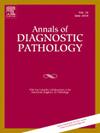Impact of the 2022 Paris System on diagnostic accuracy and estimating the risk of high-grade malignancy in urine cytology
IF 1.4
4区 医学
Q3 PATHOLOGY
引用次数: 0
Abstract
In 2016, The Paris System 1.0 (TPS 1.0) was introduced to overcome the problem of lack of a standardized reporting system and leading to diagnostic dilemmas for treating physicians. Following this, TPS 2.0 was introduced in 2022 to deal with certain limitations of TPS 1.0. Objectives of study: To evaluate the diagnostic accuracy and risk of malignancy (ROM) with risk of high-grade malignancy (ROHM) of urinary tract by of TPS 2.0 with TPS 1.0 and conventional reporting (CR) of urine cytology. Data were collected retrospectively from 2016 to 2023 from the departmental archives. The cases were reviewed and categorized as per TPS 2.0, TPS 1.0 and CR. Of 875 urine samples studied, 168 urine samples of patients with histology correlation were analyzed. TPS 2.0 had a maximum sensitivity of 64.2 % in Group A, highest specificity of 95.5, positive predictive value of 96.4 % and negative predictive value of 37.5 % in group B comparison to TPS 1.0 and CR. TPS 2.0 has significantly high sensitivity, and maximum receiver operating curve (ROC) with area under the curve (AUC) score (0.695) compared to TPS 1.0 and CR. TPS 2.0 predicted ROM for AUC, SHGUC and HGUC categories 67.6 %, 92 % and 96.8 %, whereas ROHM 26.5 %, 46.2 %, and 98.8 %, respectively. CR and TPS 1.0 predicted ROHM (95.2 % and 81.5 %), respectively. Implementation of TPS 2.0 revealed highest diagnostic accuracy and ROC AUC score for urinary tract malignancy, compared to TPS 1.0 and CR. Our study results highlight the impact of TPS 2.0 in urine cytology reporting.
2022年巴黎体系对尿细胞学诊断准确性和估计高级别恶性肿瘤风险的影响
2016 年,巴黎系统 1.0(TPS 1.0)问世,以解决缺乏标准化报告系统并导致主治医生诊断困难的问题。随后,巴黎系统 2.0 于 2022 年推出,以解决巴黎系统 1.0 的某些局限性。研究目的:评估 TPS 2.0 与 TPS 1.0 和尿液细胞学常规报告(CR)的诊断准确性、恶性肿瘤风险(ROM)和高级别恶性肿瘤风险(ROHM)。从科室档案中回顾性收集了2016年至2023年的数据。根据 TPS 2.0、TPS 1.0 和 CR 对病例进行了审查和分类。在研究的 875 份尿液样本中,分析了 168 份与组织学相关的患者尿液样本。与 TPS 1.0 和 CR 相比,TPS 2.0 在 A 组的灵敏度最高,为 64.2%,特异性最高,为 95.5%,阳性预测值为 96.4%,B 组的阴性预测值为 37.5%。与 TPS 1.0 和 CR 相比,TPS 2.0 的灵敏度明显较高,接收者操作曲线(ROC)最大,曲线下面积(AUC)为 0.695。TPS 2.0 对 AUC、SHGUC 和 HGUC 类别的 ROM 预测率分别为 67.6%、92% 和 96.8%,而 ROHM 分别为 26.5%、46.2% 和 98.8%。CR 和 TPS 1.0 预测的 ROHM 分别为 95.2 % 和 81.5 %。与 TPS 1.0 和 CR 相比,TPS 2.0 对尿路恶性肿瘤的诊断准确率和 ROC AUC 得分最高。我们的研究结果凸显了 TPS 2.0 对尿液细胞学报告的影响。
本文章由计算机程序翻译,如有差异,请以英文原文为准。
求助全文
约1分钟内获得全文
求助全文
来源期刊
CiteScore
3.90
自引率
5.00%
发文量
149
审稿时长
26 days
期刊介绍:
A peer-reviewed journal devoted to the publication of articles dealing with traditional morphologic studies using standard diagnostic techniques and stressing clinicopathological correlations and scientific observation of relevance to the daily practice of pathology. Special features include pathologic-radiologic correlations and pathologic-cytologic correlations.

 求助内容:
求助内容: 应助结果提醒方式:
应助结果提醒方式:


